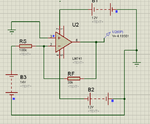QutabBaig
Newbie level 4
Hi
I wish to read a 12 V battery voltage on Arduino Mega 2560 ADC pin. To do that, there are two methods.
1. Use a voltage divider circuit.
2. Use an op-amp that would attenuate the voltage to keep it as low as 5 V like in given figure I m reading 14 V of battery by scaling it down to 4.19 V. My controller will read this 4.19 V as 14 V and I will do programming accordingly.

Now the issue I m having is if I go with second method, do I need to worry about current. Is there any possibility that a large current may flow through op-amp towards controller and ending up burning my op-amp and controller? Is there any op-amp which can sustain high currents?
Pl assist
I wish to read a 12 V battery voltage on Arduino Mega 2560 ADC pin. To do that, there are two methods.
1. Use a voltage divider circuit.
2. Use an op-amp that would attenuate the voltage to keep it as low as 5 V like in given figure I m reading 14 V of battery by scaling it down to 4.19 V. My controller will read this 4.19 V as 14 V and I will do programming accordingly.

Now the issue I m having is if I go with second method, do I need to worry about current. Is there any possibility that a large current may flow through op-amp towards controller and ending up burning my op-amp and controller? Is there any op-amp which can sustain high currents?
Pl assist